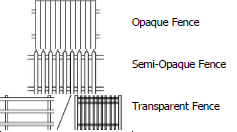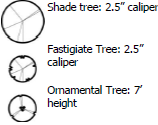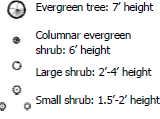Development subject to the requirements of this section shall provide buffering in accordance with this subsection.
(a) Buffer types. Table 1216-3 describes three different buffering standards in terms of opacity. Where a particular buffer type is required in Table 1216-4
, the requirements may be met with the combination of minimum buffer width and planting requirements specified in Table 1216-3.
Option 1: Buffer Width 35' | Option 2: Buffer Width 15' | Option 3: Buffer Width 5' | |
Option 1: Buffer Width 35' | Option 2: Buffer Width 15' | Option 3: Buffer Width 5' | |
BUFFER TYPE A: OPAQUE This perimeter buffer function as an opaque screen and prevents visual contact between uses and creates a strong impression of total separation. |  |  |  |
• 3 shade trees, 40' O.C. • 11 evergreen trees, 12' O.C. • 17 large shrubs1, 5.5' O.C. | • 2 shade trees, 40' O.C. • 6 evergreen trees, 12' O.C. • 14 small shrubs1, 4' O.C. | • 4 fastigiate trees, 30' O.C. • 6' opaque fence or brick or stone wall | |
BUFFER TYPE B: SEMI-OPAQUE This perimeter functions as a semi- opaque screen. |  |  |  |
• 3 shade trees, 40' O.C. • 6 evergreen trees, 12' O.C. • 13 large shrubs2, 5.5' O.C. | • 3 shade trees, 40' O.C. • 6 large shrubs2, 5' O.C. • 22 small shrubs2, 4' O.C. | • Cluster of 2 ornamental or fastigiate trees, 80' O.C. between clusters • 10 columnar evergreen shrubs2, 4' O.C. • 10 small shrubs2, 4' O.C. | |
BUFFER TYPE C: LIGHT This buffer functions as an intermittent visual obstruction and creates the impression of spatial separation without eliminating visual contact between uses. |  |  |  |
• 2 shade trees and clusters of 2 ornamental trees, 40' O.C. between shade trees/clusters • 2 ornamental trees, 15' O.C. • 17 large shrubs3, 5.5' O.C. | • 3 shade trees, 40' O.C. • 13 large shrubs3, 5.5' O.C. | • 2 ornamental or fastigiated trees, 40' O.C. • 14 small shrubs or mix of shrubs/perennials3, 4' O.C. or planted in clusters, 40' O.C. between clusters. | |
 |  |  | |
1: May substitute shrubs with 6' opaque fence or brick or stone wall
2: May substitute shrubs with 6' semi-opaque fence or brick or stone wall
3: May substitute shrubs with 4' transparent fence or 3' brick or stone wall segments
O.C.: On Center; all On-Center dimensions are approximate
(b) Required buffers.
(1) Table 1216-4 specifies the type of landscape buffer that a new development shall provide between it and adjacent properties, based on the use of the development site and that of adjacent properties. The buffer type is indicated by a letter corresponding to one of the three buffer types depicted in Table 1216-3.
(2) Landscape buffers shall only be required along lot lines that are adjacent to lots located within the Middletown municipal boundaries or are located adjacent to residential subdivisions, regardless if the subdivision is within the Middleton municipal boundaries.
(3) No buffer shall be required in the UC District, except for when a vehicular use area has frontage along a public street, in which case, the vehicular use area shall be buffered with a Type C Buffer.
(4) A residential subdivision or the construction of a single-family, two-family, or three-family dwelling shall not be required to install a buffer when adjacent to a different use.
(5) When reviewing a conditional use application, the Planning Commission may require additional buffer treatments or may waive certain requirements based on a case-by-case basis.
Adjacent To: |
Any Use in a R-1, R-2,or R-3 District
|
Any Lot in an R-4 District
|
Any Lot with a Public or Institutional Use in a Nonresidential District
|
Any Lot in a O-1, O-2,B-1, or UC District
|
Any Lot in a B-2,B-3, or BC District
|
Any Lot in an I-1 or I-2 District
|
Adjacent To: |
Any Use in a R-1, R-2,or R-3 District
|
Any Lot in an R-4 District
|
Any Lot with a Public or Institutional Use in a Nonresidential District
|
Any Lot in a O-1, O-2,B-1, or UC District
|
Any Lot in a B-2,B-3, or BC District
|
Any Lot in an I-1 or I-2 District
|
Proposed Use: | ||||||
Multi-family dwellings and uses in the Group Living Use Category | C | None | ||||
Any Public and Institutional Use | B | C | None | |||
Any use in the O-1, O-2, or B-1 Districts | B | B | None | |||
Any use in the B-2, B-3, or BC Districts | A | B | None | |||
Any use in the I-1 District | A | A | C | None | ||
Any use in the I-2 District | A | A | C | C | C | None |
(c) Alternative buffering options. An applicant may propose an alternative to the buffer requirements if approved through the alternative equivalent compliance procedure. See § 1226.09.
(d) Buffer establishment. Once a buffer has been approved by the Development Code Administrator and established by the owner, it may not be used, disturbed or altered for any purpose unless otherwise permitted by the City.
(e) Location of buffers.
(1) The landscape buffer shall be provided along the entire lot line between the two adjacent uses identified in Table 1216-4.
(2) Buffers required by this section shall be located completely on the lot subject to the buffer requirement and only along the outer perimeter of the lot where it abuts another lot, and shall extend to the lot line or right-of-way line.
(3) The only exceptions to division (e)(2) hereof are:
A. If a landscape buffer, required by this code, is established on the adjacent lot and is permanently protected as a buffer in accordance with the provisions of this code and cannot be removed or disturbed in the future; or
B. If a unique characteristic of the lot (e.g., an existing stand of woods or existing vegetation that is not on the perimeter of the site) would create a better option to the required buffer type.
(f) Development within required buffers. The required buffer shall not contain any development, impervious surfaces, or site features (except fences or walls) that do not function to meet the standards of this section or that require removal of existing vegetation, except for the following features:
(1) Fences or walls;
(2) Sidewalks, trails, and other elements associated with passive recreation, if all required landscaping is provided;
(3) Signs and light posts;
(4) Driveways, access roads, and similar uses if they cross perpendicularly across a required buffer, are designed to limit disturbance of vegetation, and have a maximum width of 24 feet; or
(5) Overhead and underground utilities required or allowed by the City.
(Ord. O2018-02, passed 2-20-2018)